How To Build Screen Sharing Into My App
In the last year, the amount of work happening remotely has skyrocketed—and that means more and more of us are using software exclusively to communicate and work together with coworkers. For many, screen sharing software is a vital part of that.
Use automation to support brainstorming, delegation, and communication
When done right, screen sharing makes it easy to remotely collaborate on documents, co-browse, demo products, onboard new customers, and more. When done poorly, screen sharing can give you a huge headache and send nightmare incantations of "Can you see my screen yet?" ricocheting through your brain.
That's why choosing the best screen sharing software matters. To help you avoid that nightmare scenario, we've tried and tested dozens of apps for screen sharing. Below, we share the top eight—the best screen sharing software for a variety of use cases.
The 8 best screen sharing apps
-
Zoom for everyday screen sharing
-
Screenleap for quickly sharing your screen with anyone
-
Slack for collaborative team meetings
-
Surfly for co-browsing your app with leads and customers
-
Drovio for free creative collaboration
-
Google Meet for Google ecosystem users
-
Microsoft Teams for Microsoft 365 users
-
Demodesk for sales calls and presentations
What makes great screen sharing software?
Screen sharing software can be used for anything from webinar presentations, to sales calls, to a quick gut check on a design with a colleague. At its most basic, it's software that allows users to share their screens with other people online. But the best software offers more—so we weighed a number of factors when making our picks:
-
Ease of access for participants. The best software includes no-install web access and can be used across devices.
-
Collaboration features. We looked for features like presenter-switching, joint annotation, co-browsing, and collaborative document editing.
-
Mobile user experience. Whether in-app or in-browser, the top software offers a mobile experience on par with being on desktop.
-
Integrations. Being able to automate tasks like scheduling sessions and uploading recordings makes the whole process simpler.
-
Affordability. The best screen sharing tools shouldn't bust the budget in exchange for reasonable time limits, features, and participants.
While many remote access tools are also capable screen sharing apps, we've omitted any software that's built primarily for remote access, like TeamViewer and Windows Quick Assist. We also haven't tested every single video conferencing app out there (that's a different article!), so if you already use a video tool that isn't on our list, it's worth looking into the screen sharing functionality it offers.
Best screen sharing software for everyday use
Zoom (Mac, Windows, Linux, iOS, Android)
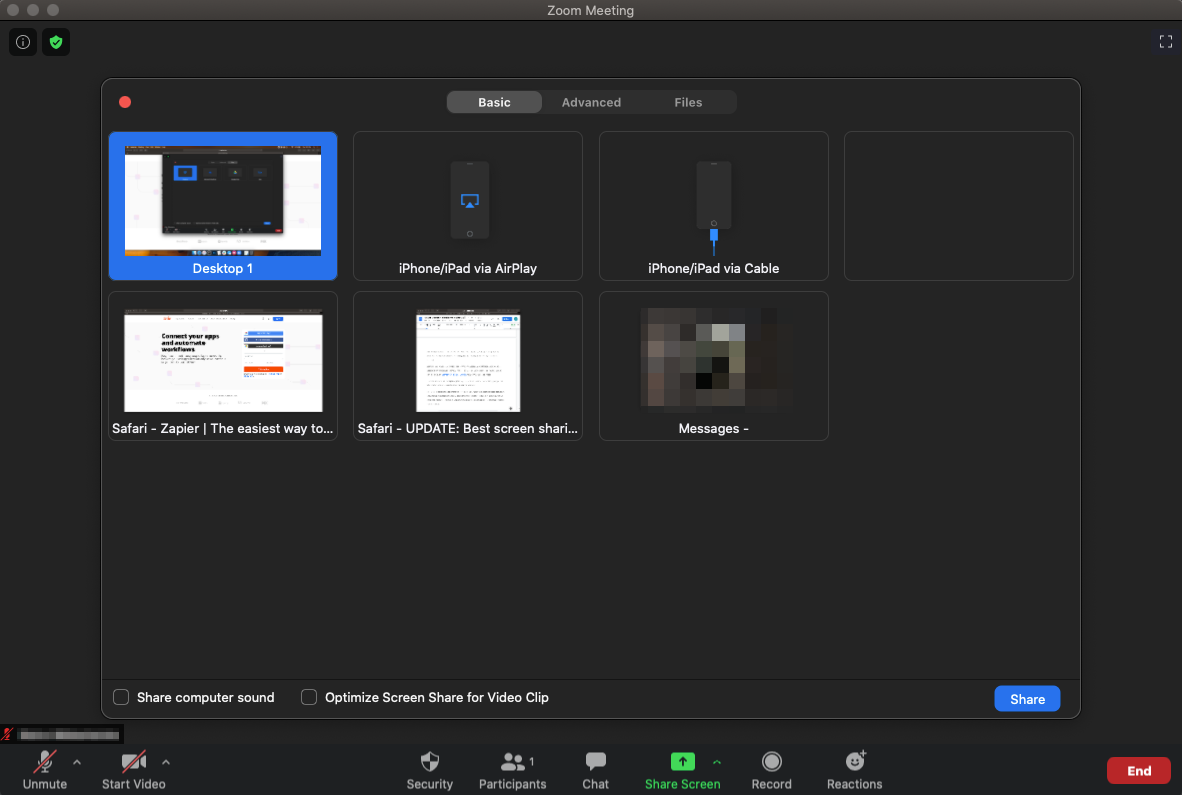
Zoom is considered one of the best video conferencing apps for handling team meetings, sales demos, and webinars. As long-time users, we can personally vouch for its reliability.
Even over choppy networks, Zoom manages to maintain a video connection by adjusting quality depending on bandwidth. This is especially useful for screen sharing, which is something Zoom makes easy, no matter the circumstances.
Zoom provides a lightweight installer for practically every operating system, Linux distribution, and mobile OS, so hosting a screen sharing session for a non-Zoom user isn't likely to cause compatibility issues or awkward waiting periods.
Zoom users can host screen sharing meetings from apps for desktop or mobile. On the mobile apps, participants can take control of the presentation tools to share documents or co-annotate.
Since Zoom is a sophisticated video conferencing tool with screen sharing built in, the calling and meeting features are enough to support businesses of any size: 50 people can join a room on the free plan, and paid plans allow up to 500 participants. This is great for putting on a webinar with multiple hosts who each need to access the same presentation screen to annotate.
You can automate your screen share sessions for an even more seamless process by connecting Zoom with Zapier, which allows you to do things like automatically email Zoom links for new bookings. You can also automatically upload Zoom recordings to Google Drive or another cloud storage platform, so even people who couldn't make the meeting can see your screen.
Zoom pricing: Free with a 40-minute limit on group meetings; from $14.99/user/month for up to 24 hours of meeting time.
Best screen sharing software for quickly sharing your screen with anyone
Screenleap (Web, Windows, Mac, iOS, Android, Chrome)
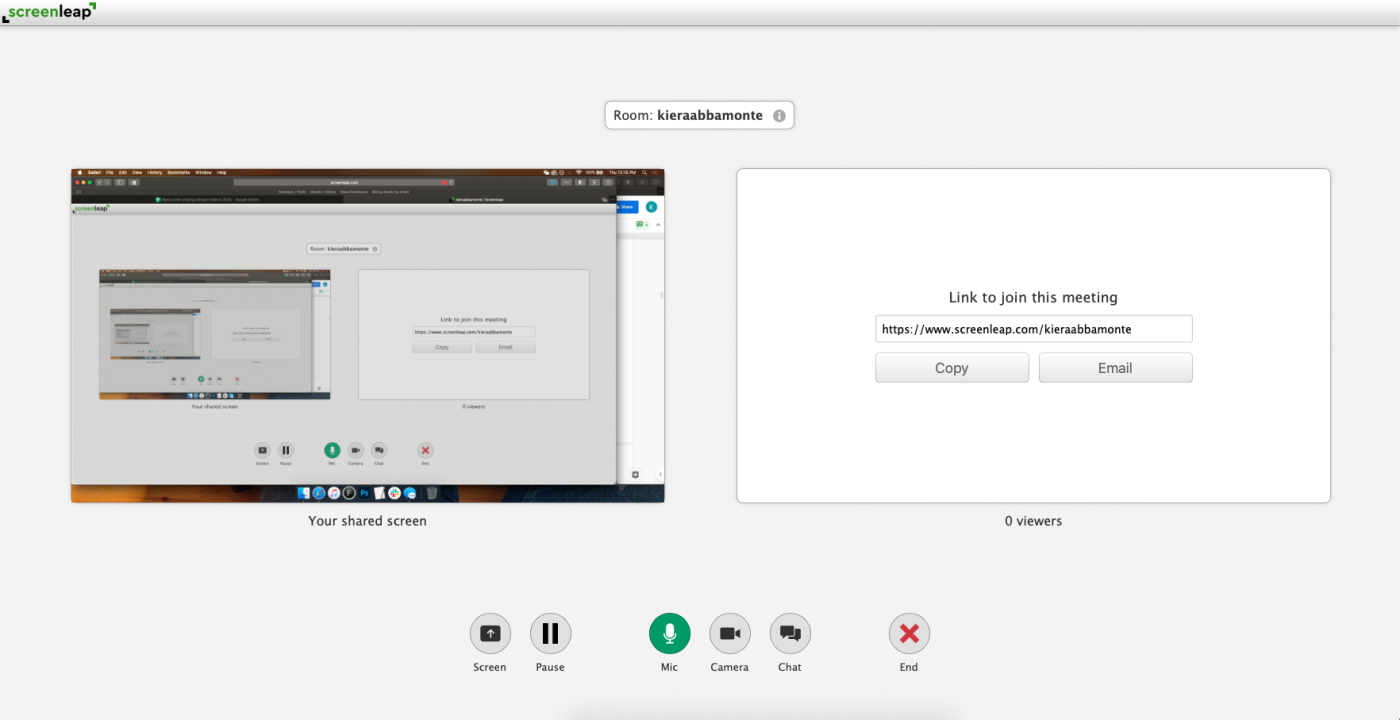
Screenleap is one of the most bare-bones screen sharing tools out there, but its lack of complexity makes it lightning fast to use. It's ideal when you need to give a quick tutorial to a colleague or present to a client without forcing them to download and install something heavy-duty or even jump onto a videoconferencing app.
With Screenleap, you get a permanent URL that anyone with the link can use to join the session when you're sharing (it will tell them to wait if you're not actively sharing). It's great for including in the calendar event description for recurring meetings or quickly accessing when you need to go live.
You can also share your screen via a six-digit share code that participants can enter on the Screenleap homepage, so both webinar-style sessions and sales demos are easy to manage.
Broadcasts, which offer one-way audio conferencing, and private sessions, which are joined with a disposable passcode, can be kicked off with one click in the Chrome extension or from the Screenleap dashboard. And since it's browser-based, it means participants can join regardless of their device or setup. Watching a screen share is just as smooth from a mobile browser as it is on desktop.
With this simplicity comes trade-offs. Screenleap doesn't support video or two-way conferencing or annotation, making it less useful for collaborative team meetings than a dedicated tool would be. It's still ideal for launching fast, low-friction screen sharing sessions right from the browser—especially if you can't afford to spend 10 minutes asking "can you see it yet?" while your participants install new software.
Screenleap Pricing: Free for 40 minutes of screen sharing per day; paid plans from $15/month (billed annually) for up to eight hours of screen sharing per day.
Best screen sharing software for collaborative internal meetings
Slack (Windows, Mac, Linux, iOS, Android)
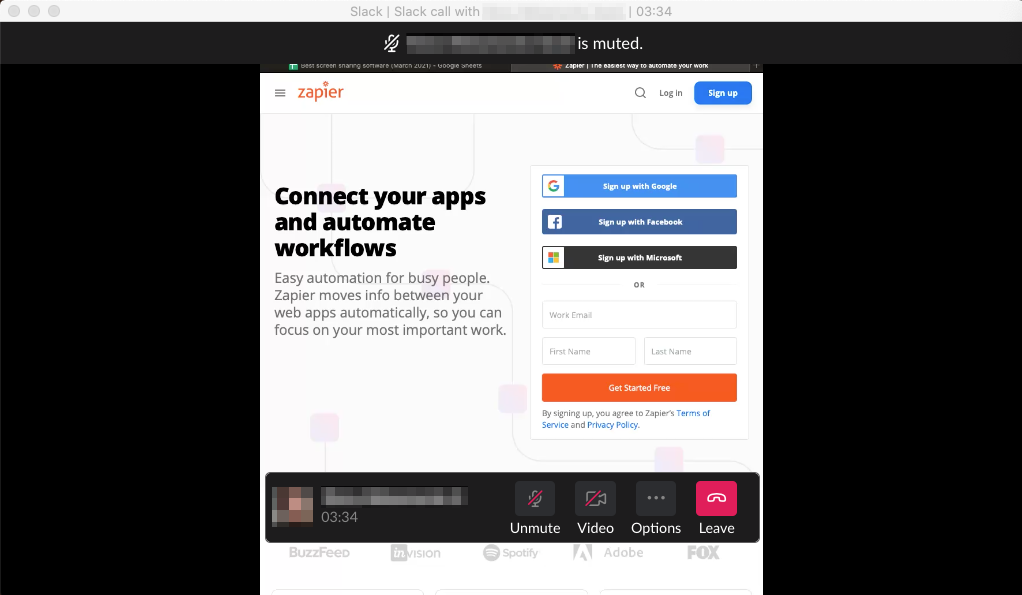
Slack is probably where you and your team already hang out. With so many integrations with the other apps you use at work, it's like a dashboard and universal activity feed. Since so much is already going on inside Slack, why not use the same tool to host and record your meetings?
For internal collaboration, there's no need to pay for another screen sharing tool if you're already paying for Slack. Sessions can be held privately or kept open for the members of a channel to hop in and out of. Each session is recorded and kept archived in the channel—and it's searchable, like the rest of your communication logs.
Slack's screen sharing includes host switching, collaborative annotation, and the ability for each participant to use their own cursor on the host's screen. The host simply clicks the cursor icon while sharing their screen to allow access.
However, teams that need a solution for mobile and Linux will find these features restricted: Screen shares with a video element aren't supported on mobile, and the Linux desktop app doesn't support remote access or others annotating the screen.
Slack also integrates with Zapier, meaning you can do things like automatically send approaching calendar events to a Slack channel, so you're ready when it's time to screen share.
Slack pricing: From $6.67/user/month (billed annually) for a plan that includes screen sharing.
Best screen sharing software for high-touch customer onboarding
Surfly (Web)
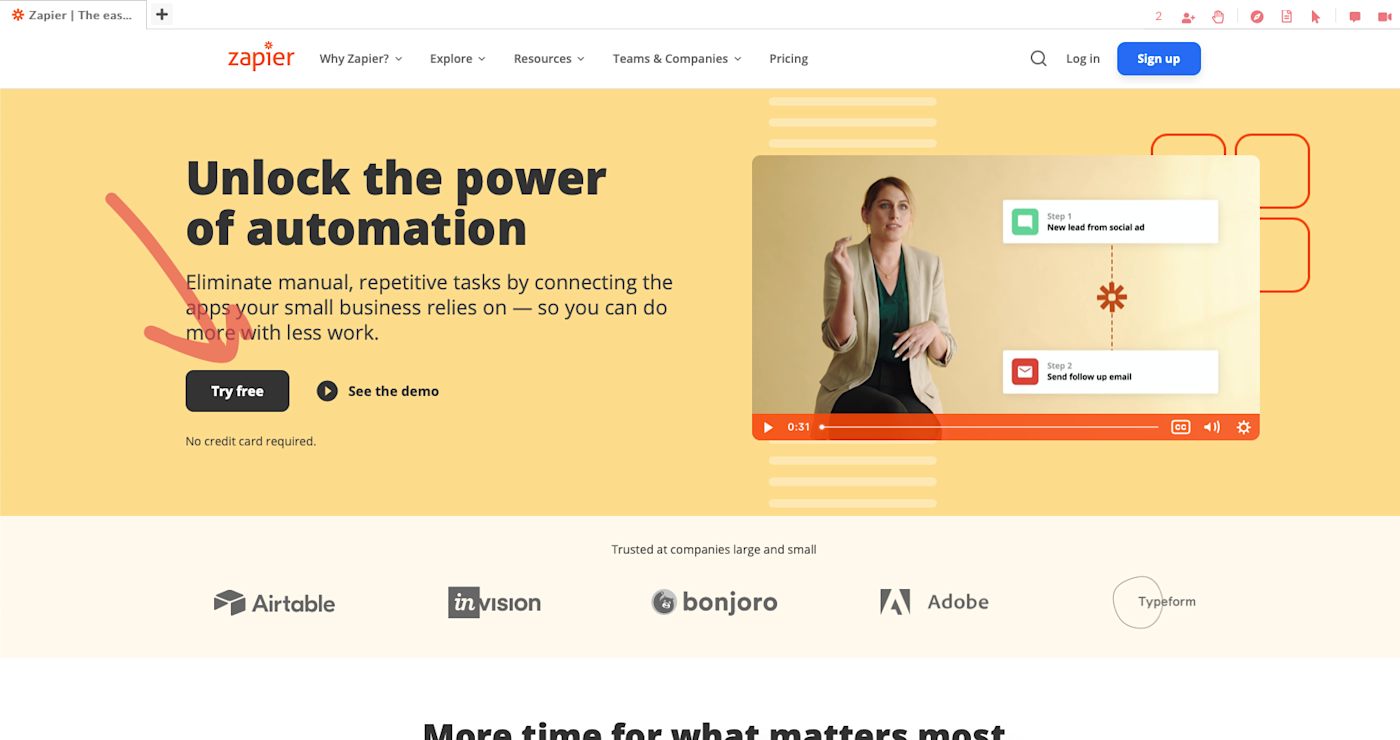
Surfly is a co-browsing tool for remote support and sales that can be embedded into a website or SaaS app. It integrates with support widget tools like Intercom, Zendesk, and Olark to offer an easy way for users to connect with support agents.
Once connected, agents can highlight the elements on the page the user should click—and you can use it to video conference too. It's an interactive way to train a customer using screen sharing, and it's lower-friction, too, because you aren't directing your user outside of your website or app.
Screen sharing is enabled browser-to-browser without either party needing to download a tool. Since it's confined to the browser, you can be sure that you're only showing your website or software, instead of your personal photo library, bookmarks, and iMessage notifications.
Surfly Pricing: From $26/user/month for basic features.
Best screen sharing software for free creative collaboration
Drovio (Mac, Windows, Linux)
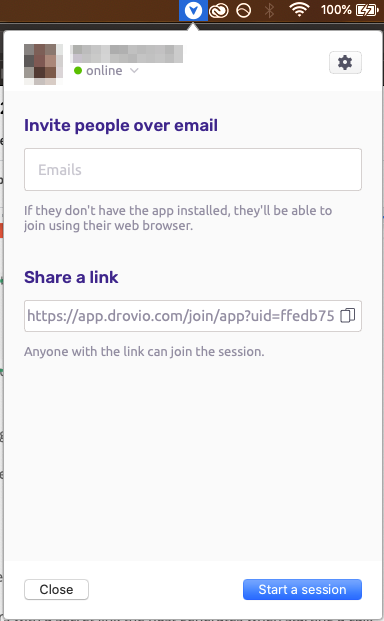
Drovio (formerly USE Together) is designed with activities like pair programming and designing in mind. All Drovio screen sharing session participants get a cursor they can use to control the host's screen, so multiple users can simultaneously work in different parts of the same screen while on a voice call.
Right now, the Mac, Windows, or Linux desktop app is required to host a screen sharing session or participate with your cursor, but viewers can watch from their web browsers with a secret link the host generates when starting a call. Users can restrict what others can see and do on their screen by sharing just one application instead of the whole desktop, and a host can take back control at any moment, preventing any abuse.
Drovio Pricing: Free for two participants, unlimited screen sharing, and 30 minutes/day of remote screen control; paid plans from $15/month.
Best screen sharing software for Google ecosystem users
Google Meet (Web)
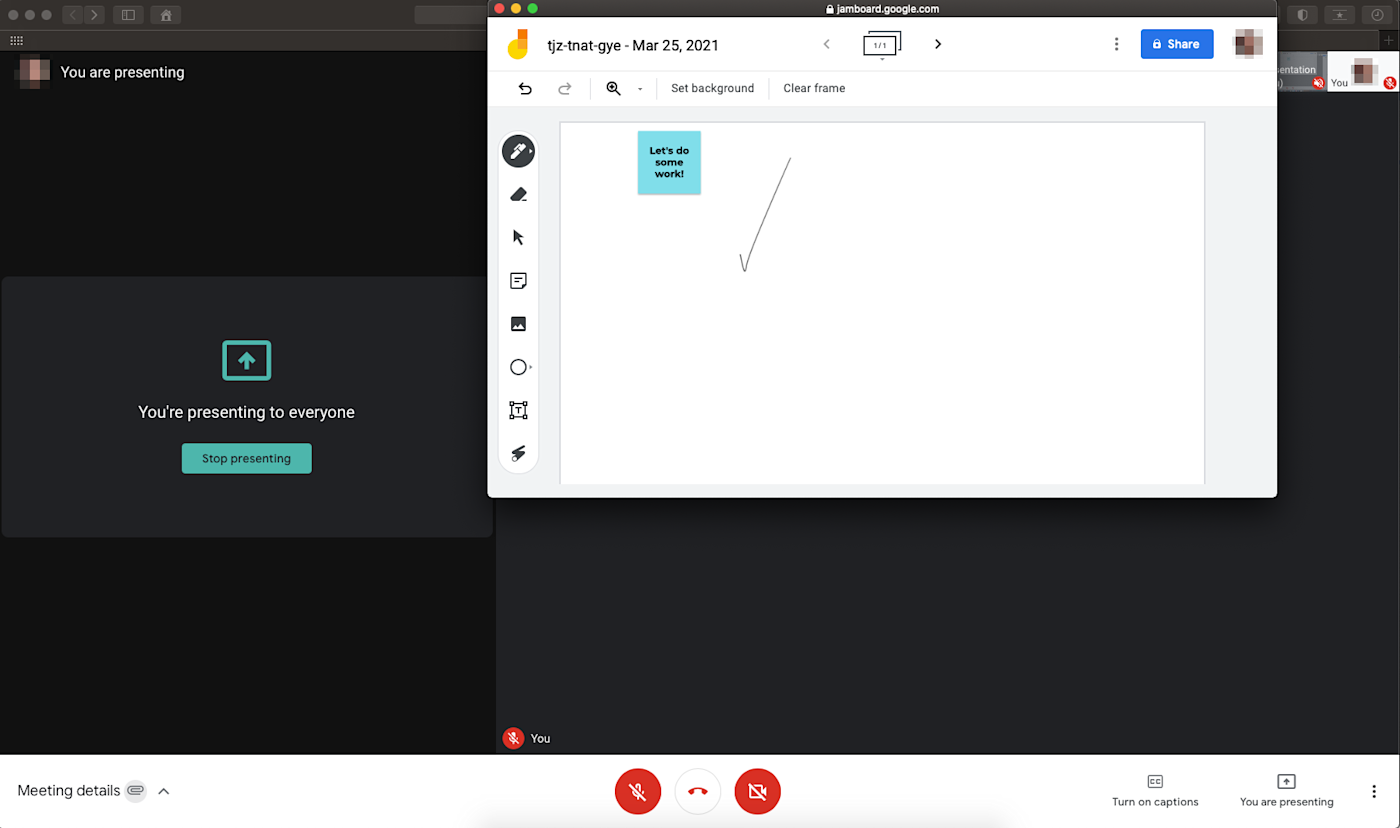
Built for business use and living right inside your Gmail inbox, Google Meet marks a huge improvement over its predecessor, Hangouts. It has a robust free plan (unlimited hour-long meetings with up to 100 people), and it's part of the deal if you already pay for Google Workspace.
From your Gmail inbox, it takes just two clicks to start or join a meeting, and only two more clicks from there to start sharing your screen. Follow the same process from the Gmail mobile app to screen share on the go. Plus, the mobile app will remind you to turn Do Not Disturb on as soon as you share your screen.
All participants need to do is click the link provided (either by email or copy/paste) and they're in—no downloads, setup, or sign-in required. If there's one weakness here, it's that the tool only lets you share your entire screen, not a portion or a specific app.
As a Google product, Meet works seamlessly with the rest of the Google suite, including Calendar, Drive, and the rest. That extends to the whiteboarding feature, which enables users to pull in any file from Drive or start a blank Jamboard session. The software also works with other popular calendar and scheduling apps, including Calendly.
Plus, Google Meet integrates with Zapier, allowing you to do things like automatically send Google Meet links to new leads or create a meeting link from a task, so you're ready to screen share when it's time.
Google Meet Pricing: Free plan available; part of Google Workspace starting at $8/user/month.
Best screen sharing software for Microsoft 365 Business users
Microsoft Teams (Web, Windows, Mac, iOS, Android)
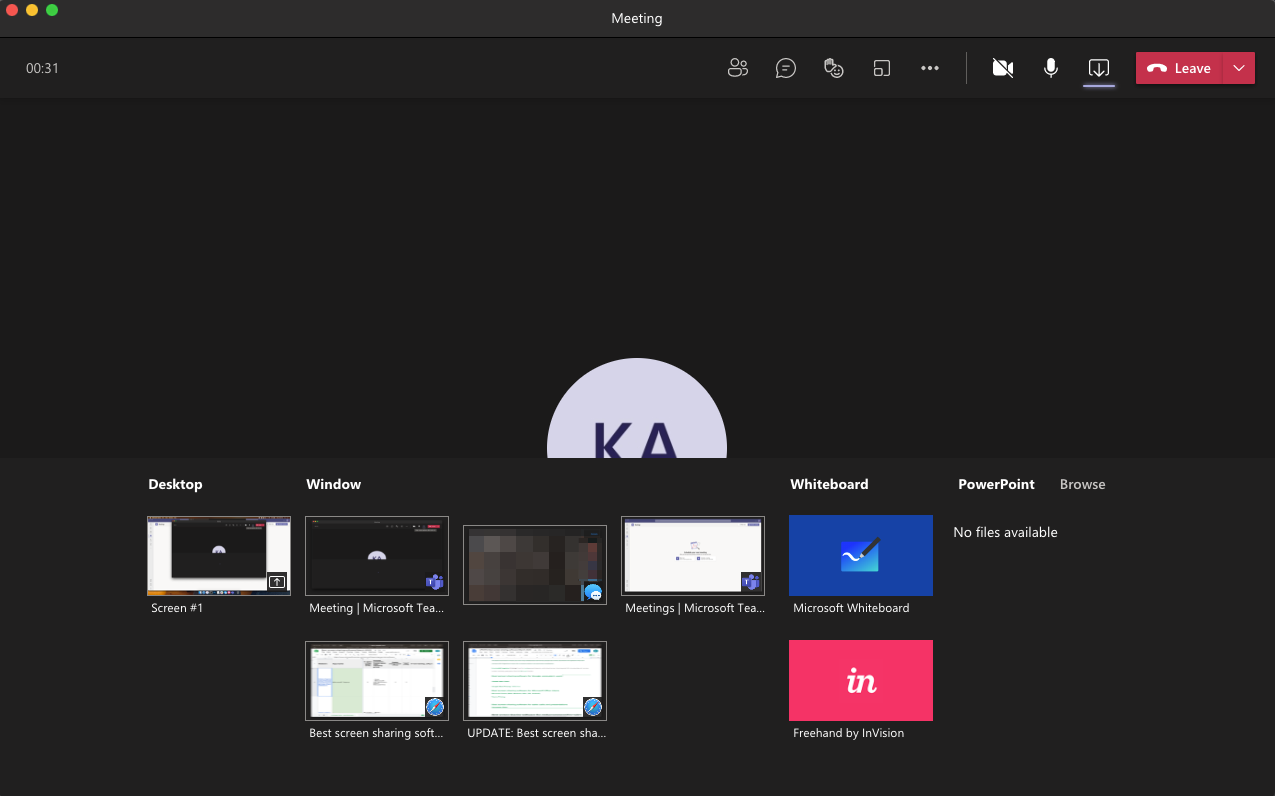
As Microsoft's answer to the growth in remote work, Teams makes huge improvements on similar Microsoft offerings. The software is free to use with limits, and the full version is included with all Microsoft 365 Business subscriptions. Teams is meant to be more than a screen sharing and video conferencing tool. It's built to be the central hub for chat, meetings, calls, files, and—well—teams.
Once you're inside a conference, users have the option to share their full screen, a specific window or app, a blank whiteboard, or InVision, PowerPoint, or OneDrive files. That last part is what makes it really comfortable for Microsoft superusers. While the software does support web use, it works best from inside an app—and that includes on mobile, where screen sharing is just as easy as on desktop.
As you may expect from Microsoft, there are tons of integrations available, so Teams can work with just about any other tool in your stack. That includes an integration with Zapier, which allows you to do things like post to Teams channels when a new Google Calendar event starts.
Teams Pricing: Free plan available for up to 100 participants and a 1-hour meeting maximum; included in Microsoft 365 Business plans, which start at $5/user/month.
Best screen sharing software for sales calls and presentations
Demodesk (Web)
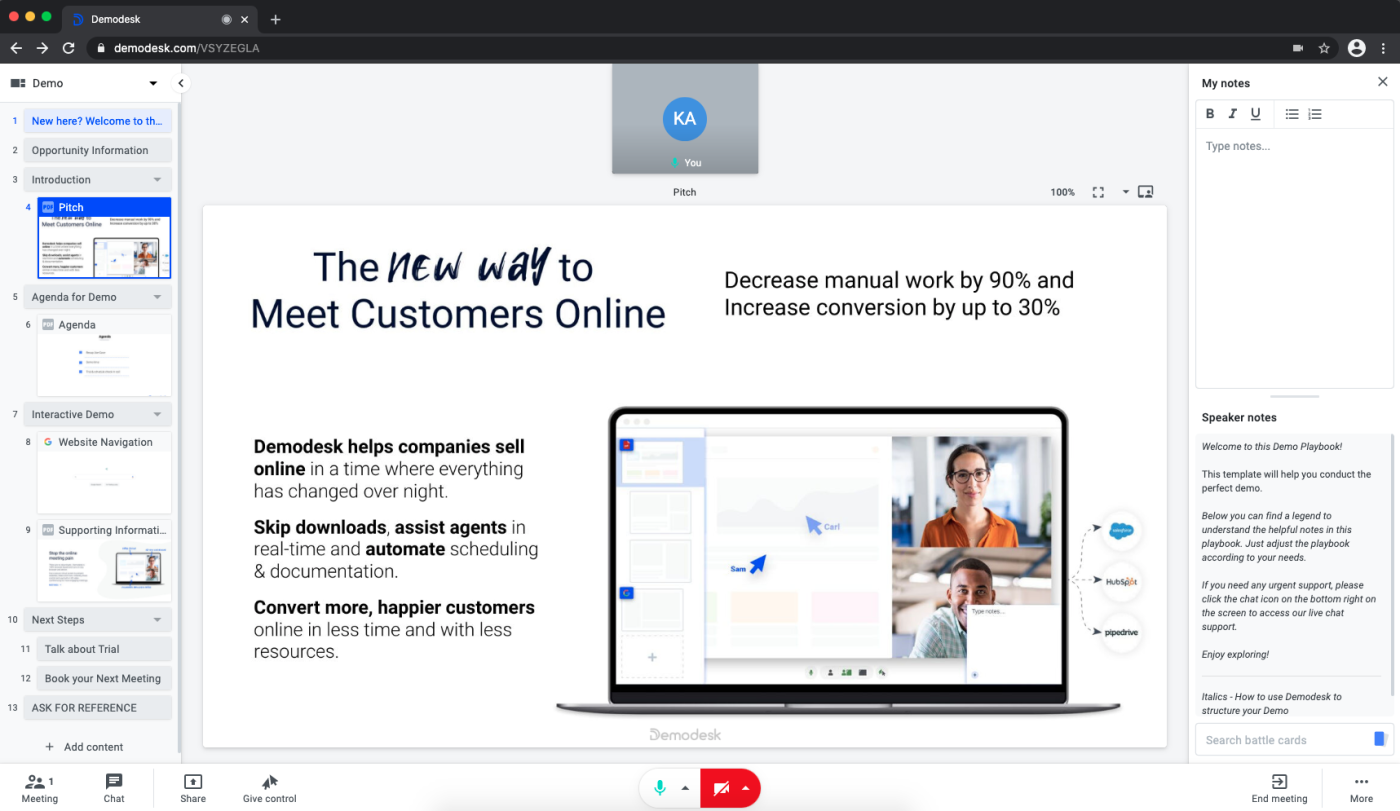
Demodesk is the best sales-focused screen sharing tool we've found. When you first sign up and log in, the software prompts you to connect your email (Gmail and Outlook 365 integrations available). Then you can start a screen share from right inside your inbox, directly from a playbook, or from the home dashboard.
Users can also make unique scheduling pages that create templated events, with the default playbook, duration, team members, booking questions, and more already set. For participants, a click of the link is all it takes to join, and the viewing experience is top-notch, even on mobile.
Unlike most screen sharing tools, the presenter's view is almost like being inside a PowerPoint or Google Slides presentation, with notes and thumbnails visible while the attendee only sees the slide. Presenters have all the information they need front and center, and there are no random notifications popping in or embarrassing photos peeking out from your desktop.
The app also includes additional sales-focused features like playbooks and battlecards that help reps react in real-time to make the sale. Users can even search their battlecards by keyword from right inside the screen share. There aren't a ton of integrations available, but the software does connect with Gmail, Outlook, Calendly, and several popular CRMs.
Demodesk Pricing: From $25/user/month for unlimited online meetings
Which app should I use?
Because screen sharing needs vary so much based on use case, you need to determine your deal breakers and nice-to-haves when it comes time to share your screen. Do you need an in-app support tool? Just a quick solution for sharing your screen with distributed team members? Each of the options above offers a unique angle in the screen sharing category.
This article was originally published in January 2019 and has since been updating with contributions from Kiera Abbamonte.
Get productivity tips delivered straight to your inbox
We'll email you 1/wk, and never share your information.
How To Build Screen Sharing Into My App
Source: https://zapier.com/blog/best-screen-sharing-software/
Posted by: deanwitilen.blogspot.com

0 Response to "How To Build Screen Sharing Into My App"
Post a Comment